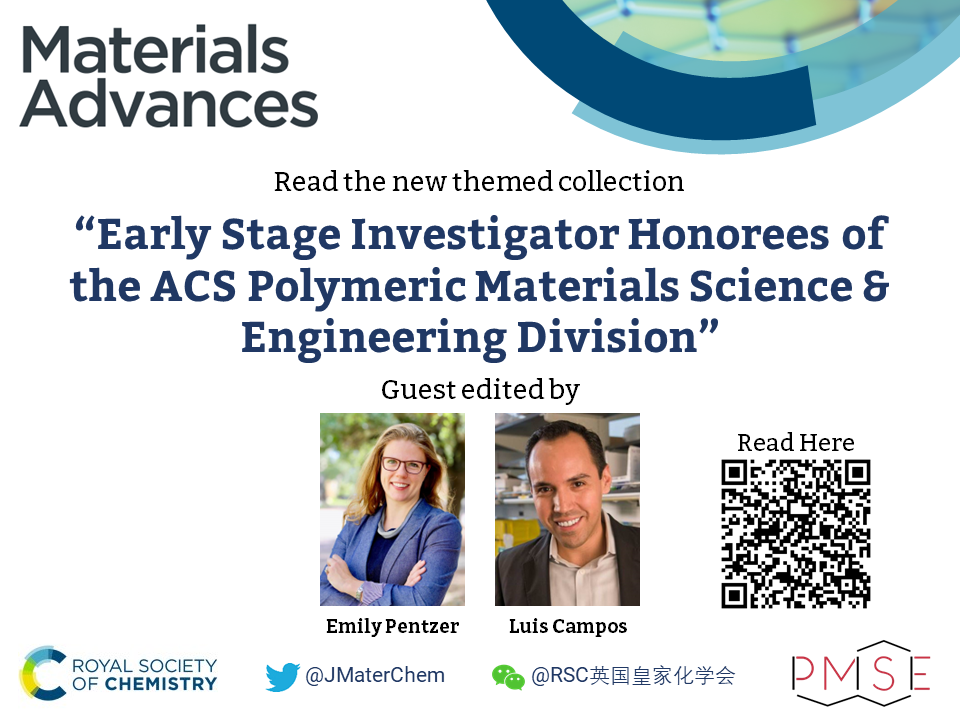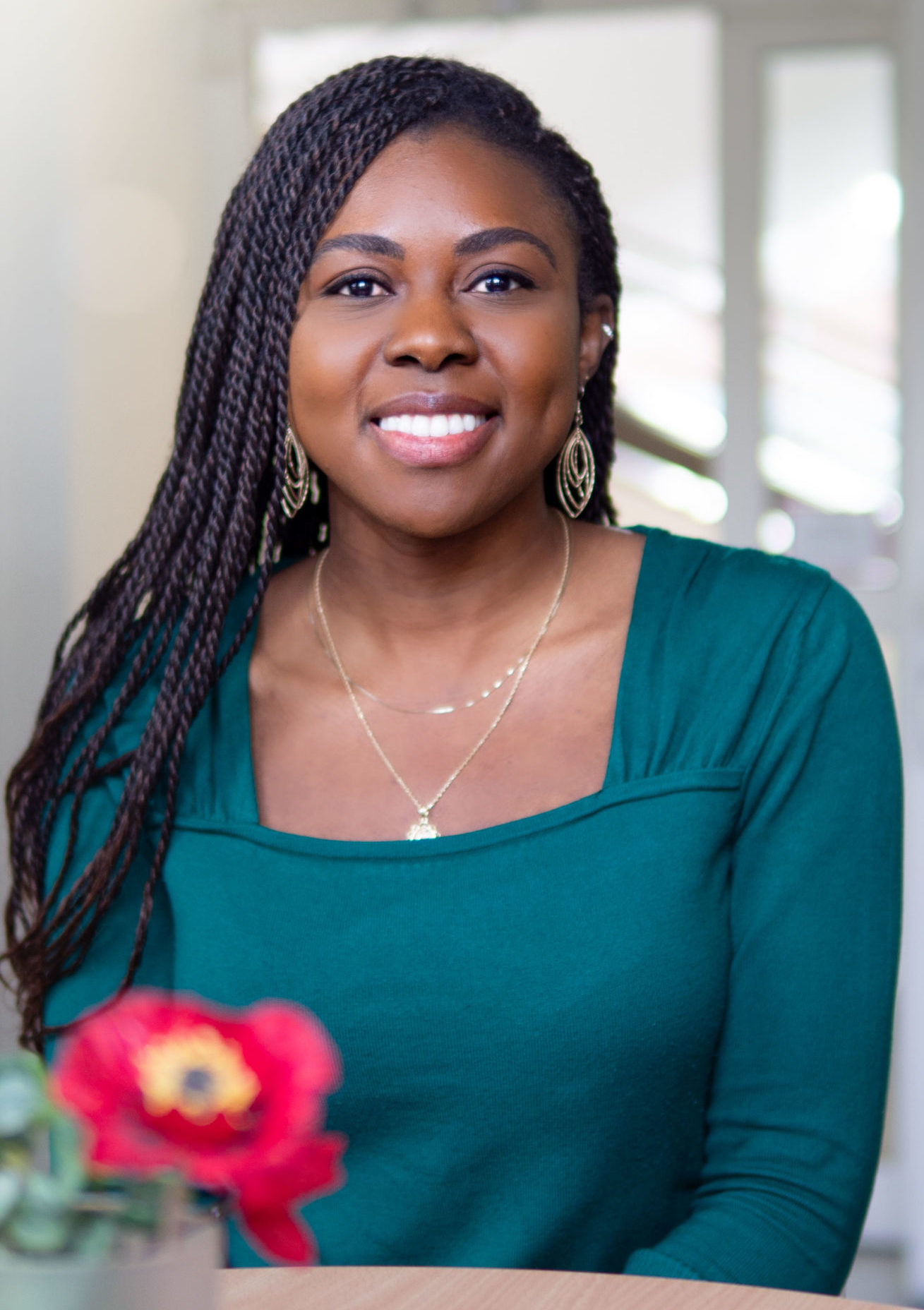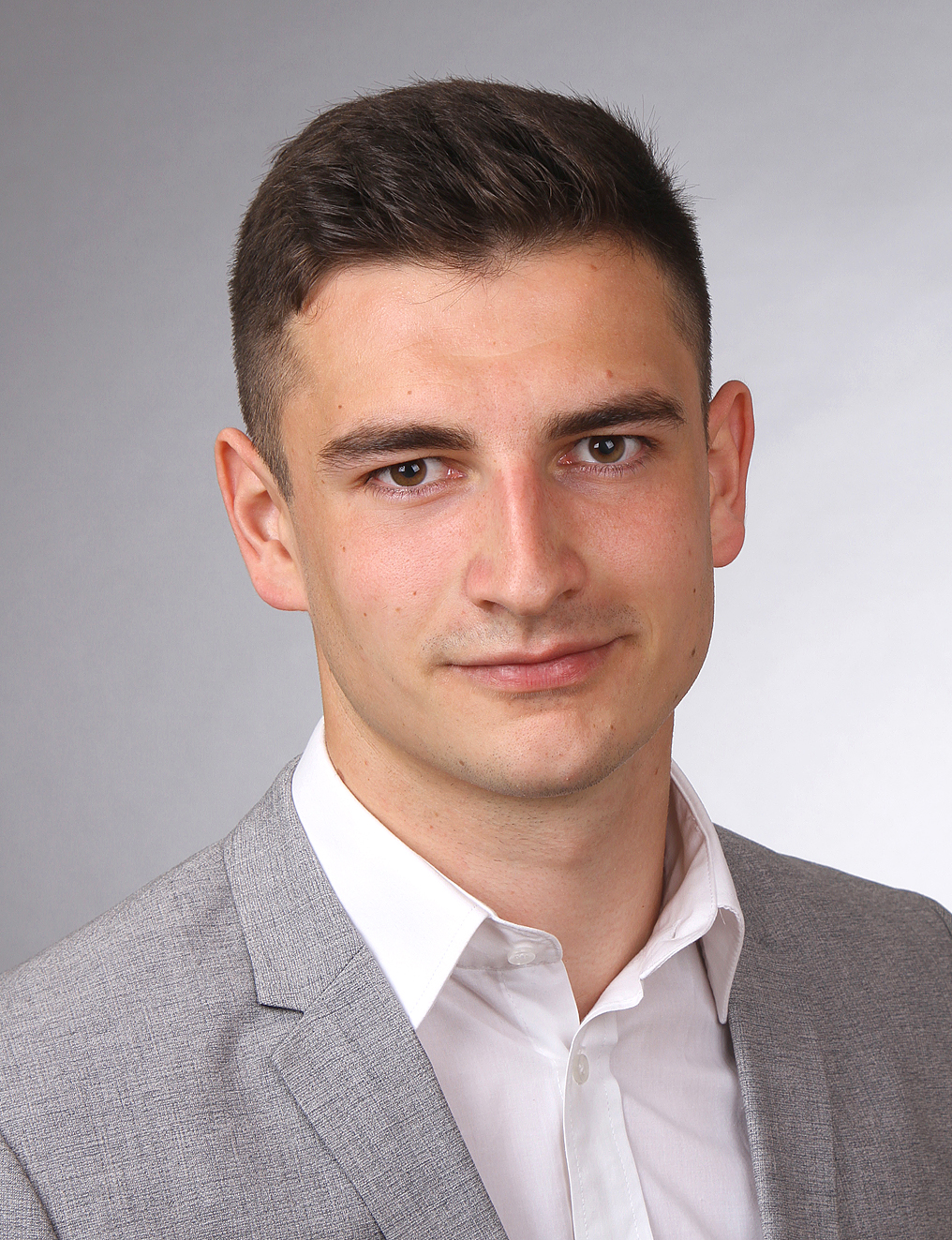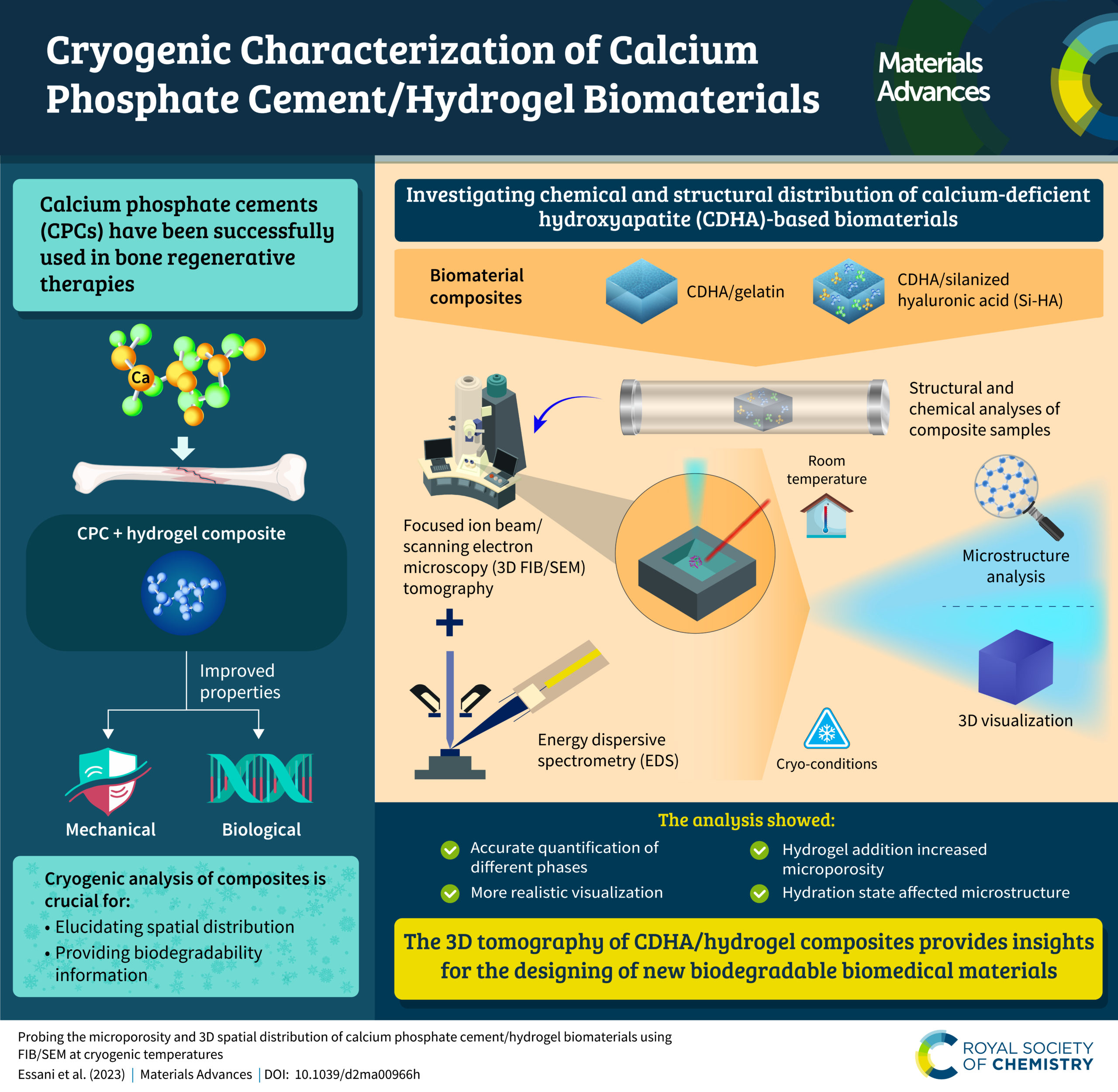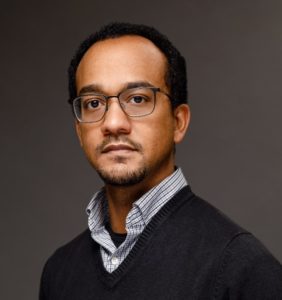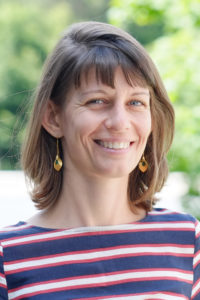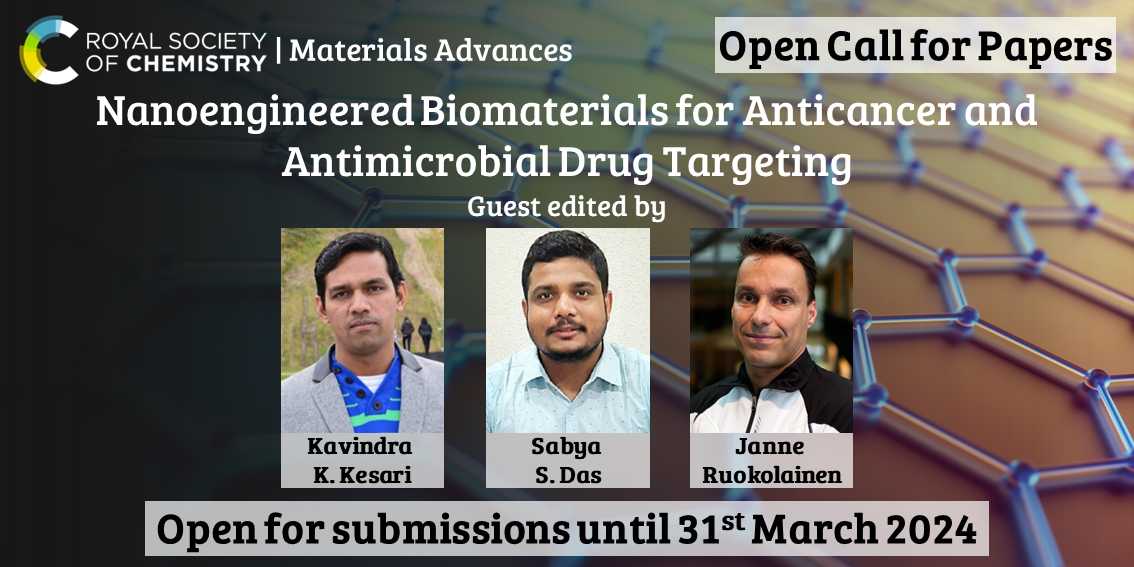This year we are pleased to celebrate 10 years since Journal of Materials Chemistry was split into three respective journals: Journal of Materials Chemistry A, B and C, each focusing on a different aspect of materials chemistry. We are grateful to our fantastic community of authors, reviewers, Board members and readers and wanted to showcase just some of them in a series of ‘Community Spotlight’ blog articles.
In this blog, we spotlight some of our first time authors in Journal of Materials Chemistry A, Journal of Materials Chemistry B and Journal of Materials Chemistry C who have published with us as corresponding authors during the anniversary year, and have had their work appear in our #MyFirstJMCA, #MyFirstJMCB or #MyFirstJMCC collections. We welcome our new community of authors and are pleased that they have chosen to publish with our journals. Find out about what some of them had to say about their experience publishing with the journals for the first time and read their featured work below.
Dr Mohammad Taha
|

Dr Taha is a multidisciplinary researcher exploring the frontiers of materials science, sustainability, and electronic engineering. With a passion for unravelling the mysteries of phase-changing materials, they strive to apply their findings in exciting fields like photonics, sensors, flexible electronics, and sustainable systems. Driven by the belief that a profound understanding of phenomena can unlock untapped potential, they are dedicated to delivering ground-breaking outcomes in their diverse areas of expertise.
|
What made you choose Journal of Materials Chemistry A as a place to publish your latest materials chemistry research?
I opted to submit my article to the Journal of Materials Chemistry A for several pertinent reasons. Primarily, I have a penchant for submitting to journals that have consistently served as dependable references during my research endeavours. Being a materials scientist and engineer, I have consistently found the articles in JMCA to be methodologically sound and intellectually stimulating, making it a journal I frequently consult. Furthermore, the journal’s thematic focus on innovative materials in the realms of energy and sustainability aligns seamlessly with both my current work and my envisioned future trajectory in the field.
Could you tell us a bit about your #MyFirstJMCA publication (DOI: 10.1039/D2TA09753B)?
My recent publication delves into the insulator-to-metal phase transition (IMT) observed in vanadium oxide polymorphs and how various structural strains influence it. Notably, the standard IMT behaviour manifests at 68 °C. In our research, we pioneer a dopant-free method to reduce the IMT temperature to approximately 40 °C, facilitating near-room temperature infrared modulation. This is achieved through a twofold approach: by precisely regulating the stoichiometry of the metal oxide to induce intrinsic strains, and by encasing the VOx particles in a SiO2 shell. The disparity in the thermal expansion coefficient between SiO2 and VOx exerts sufficient strain on the VOx, leading to a significant decrease in the IMT temperature.
Read Mohammad’s Journal of Materials Chemistry A article:
Infrared modulation via near-room-temperature phase transitions of vanadium oxides & core–shell composites
Mohammad Taha, Sivacarendran Balendhran, Peter C. Sherrell, Nick Kirkwood, Dingchen Wen, Shifan Wang, Jiajun Meng, James Bullock, Kenneth B. Crozierabe and Len Sciacca
J. Mater. Chem. A, 2023,11, 7629-7638
Dr Biswanath Das
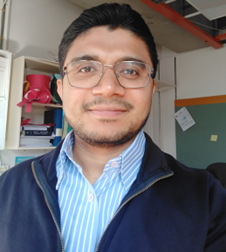
Dr. Biswanath Das is a permanent (senior) researcher and group leader at the Department of Organic Chemistry, at Stockholm University. He is an electrochemist with experience in organic-inorganic synthesis, investigation of reaction mechanisms, and electrode fabrication. His major research interest centers around finding efficient and sustainable resources for renewable energy, utilization of carbon dioxide as a C1 feedstock, and PFAS (Per- and polyfluoroalkyl substances) remediation. Biswanath earned his bachelor’s (2007, Burdwan University) and master’s (2009, IIT Kanpur) degree in India and moved to Sweden as an Erasmus Mundus Ph.D. student and conducted Ph.D. studies (2009-2013) in Lund University under the supervision of Prof. E. Nordlander on bioinorganic chemistry. Thereafter, he joined Uppsala University as a postdoctoral fellow (2014-2016) and worked on water splitting in the group of Prof. S. Ott and A/Prof. A Thapper. In 2016, he was selected for a prestigious postdoctoral fellowship (ARC affiliated) from the School of Chemistry, UNSW, Australia. During 2016-2020, he worked on carbon dioxide electroreduction and PFAS degradation in the groups of A/Prof. S B Colbran, A/Prof. G E Ball and Prof. N Kumar before joining Stockholm University as a postdoctoral researcher in the group of Prof. Em. Björn Åkermark in June 2020.
|
What made you choose Journal of Materials Chemistry A as a place to publish your latest materials chemistry research?
JMCA has a good reputation for publishing research works that are novel and highly important in the field of material chemistry. The articles published in JMCA usually attract a wide audience, which is important for the visibility of the research. We (myself, Assoc. Prof. O. Verho, and Prof. B. Åkermark) did not have any second thoughts while selecting JMCA as a suitable journal for our interesting results.
Could you tell us a bit about your #MyFirstJMCA publication (DOI: 10.1039/D3TA00071K)?
Sustainable production of green hydrogen (through water electrolysis) is one of the most important research areas of this century. This article represents the first example of a bifunctional and electrochemically regenerable molecular electrode that can be used for the unperturbed production of H2 from water at neutral pH. The special structural design of the electrode and the anchored molecular catalyst result in exciting stability and low overpotential for the electrochemical processes.
Read Biswanath’s Journal of Materials Chemistry A article:
Bifunctional and regenerable molecular electrode for water electrolysis at neutral pH
Biswanath Das, Esteban A. Toledo-Carrillo, Guoqi Li, Jonas Ståhle, Thomas Thersleff, Jianhong Chen, Lin Li, Fei Ye, Adam Slabon, Mats Göthelid, Tsu-Chien Weng, Jodie A. Yuwono, Priyank V. Kumar, Oscar Verho, Markus D. Kärkäs, Joydeep Dutta and Björn Åkermar
J. Mater. Chem. A, 2023,11, 13331-13340
Dr Johanna Meyer
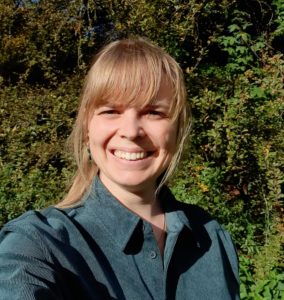
Dr. Johanna Meyer is a polymer scientist and a technical and applied chemist specialising in the development of materials for biomedical and technical approaches. After synthesizing and characterizing hydrogels, she continues to design them for various applications ranging from drug delivery and scaffold development to 3D printing of reactors. She received her PhD in 2021 from the Technical Chemistry group led by Prof. Udo Kragl at the University of Rostock (Germany) and is currently a postdoctoral fellow at the Institute of Technical Chemistry at the Leibniz Universität Hannover (Germany).
|
What made you choose Journal of Materials Chemistry B as a place to publish your latest materials chemistry research?
The RSC journals are run with significant influence of the chemistry community, upholding high editorial standards, refined reviews, and a commitment to promote diversity. The Journal of Material Science B was particularly convincing with its very good selection of publications and its general scope, making it an optimal choice for our work on 3D‑printed drug delivery systems.
What did you like most about the publication process with the journal?
The quality and constructive approach of referees has provided very valuable feedback on the manuscript and has greatly helped to improve the final published paper. I am sincerely grateful to the referees for their expert input and constructive advice.
Read Johanna’s Journal of Materials Chemistry B article:
3D printed and stimulus responsive drug delivery systems based on synthetic polyelectrolyte hydrogels manufactured via digital light processing
Sonja Vaupel, Robert Mau, Selin Kara, Hermann Seitz, Udo Kraglbc and Johanna Meyer
J. Mater. Chem. B, 2023,11, 6547-6559
Dr Shwetharani R.
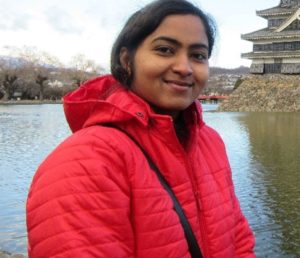
Dr. Shwetharani R is an Assistant Professor in the Department of Centre for Nano and Material Sciences at Jain Deemed to be University. Dr. Shwetha holds a PhD Degree in Chemistry (Material Sciences) from Jain Deemed to be University. Her research interests includes preparation and property tuning of semiconductor based nanomaterials, 2D materials MoS2, MoSe2, perovskite oxynitride/oxysulfide, MPX3 materials for H2/O2 evolution and also perovskite QDs property modification (CsPbX3), with a focus on renewable hydrogen generation and high PLQY perovskite QDs for sensing. She completed her postdoctoral stint at Shinshu University at Japan with the supervision of Prof. Kazunari Domen (2019-2020), as well as at Centre for Nano and Material Sciences at Jain Deemed to be University with the supervision of Prof. R Geetha Balakrishna (2016-2018) and has 7 years of experience in academia. She is passionate about development of new and efficient nanostructured materials for photo/electrochemical hydrogen/oxygen production. She believes in the power of collaboration and knowledge exchange to understand the problem in large scale production of hydrogen through economically viable process such as photocatalysis. She is a recipient of JAUW international fellowship from Japan and also received SERB-TARE project to conduct research with the supervision of Prof. S. Sampath at IISc, Bangalore (2020-2023). |
What made you choose Journal of Materials Chemistry C as a place to publish your latest materials chemistry research?
Publishing in an international high standard journal is important in the academic field, JMCC is one such journal. The quality of the research papers are excellent and this inspired me to publish in JMCC.
What did you like most about the publication process with the journal?
The publication process is fast and genuine. The reviewers are well versed in their field and suggest important comments, which drastically improves the quality of the papers. The reviewers won’t compromise on the quality of the paper and will provide comments if the paper is not up to the standards of the journal (I have received such comments before).
Read Shwetharani’s Journal of Materials Chemistry C review:
Recent advances in ecofriendly 2D monoelemental bismuthene as an emerging material for energy, catalysis and biomedical applications
Shwetharani R., Itika Kainthla, Sumanth Dongre S., Laveena D’Souzac and R. Geetha Balakrishna
J. Mater. Chem. C, 2023, 11, 6777-6799
Dr Dillip Panda

Dr. Dillip K. Panda is a Research Assistant Professor in the Materials Science and Engineering Department at Clemson University focussing on high-temperature solid-state lithium batteries and the development of various anode, cathode, and electrolyte materials for solid and liquid-based lithium-ion batteries. He obtained his Ph.D. under the tutelage of Prof. Gordon G Wallace, Intelligent Polymer Research Institute (IPRI) at the University of Wollongong, Australia. Dr. Panda then joined Florida State University (FSU) in Tallahassee, Florida as a Postdoctoral Fellow where he worked on supramolecular dyad based dye-sensitized solar cells (DSSCs), MOFs, nanomaterials (both organic and Inorganic) and chemical sensors. Then he was a UMEI PISET fellow at the University of Michigan (UMich), where he worked on synthesis, modeling and fabrication and characterization of hybrid organic- inorganic perovskite materials for high efficiency solar-to-electrical energy conversion under Prof. Bartlet and Prof. Maldonado. More than 32 peer-reviewed publications have been published over the course of his career and three separate book chapters. Aside from serving as president of the Clemson University Postdoctoral Association from 2020 to 2022, Dr Panda received the Clemson University Distinguished Postdoctoral Award in 2022. Over the course of his diverse research career, he has developed a passion for establishing and implementing collaborative and interdisciplinary research, which is a challenging task for society’s energy needs. |
What made you choose Journal of Materials Chemistry A as a place to publish your latest materials chemistry research?
Considering my field of research (materials and energy), I am very selective about which journals I submit my papers to. Journal of Materials Chemistry A is one of my favorite journals since it always publishes cutting-edge and innovative research related to energy. Journal of Materials Chemistry A reaches a large audience with a diverse background in engineering and science. The reviewers are also critical of the work and ensure it is of high quality with novelty and significant impact on the field during the revision process. We met the scope of the journal and had our work published.
Could you tell us a bit about your #MyFirstJMCA publication (DOI: 10.1039/D3TA01366A)?
I was delighted to see my article published in Journal of Materials Chemistry A, since this article highlights Silicon oxyycarbide’s electrochemical performance as an anode material. Those interested in lithium-ion batteries and other electrochemical applications will find this paper titled ” A review of silicon oxycarbide ceramics as next generation anode materials for lithium-ion batteries and other electrochemical applications” useful for their research. In lithium-ion batteries, silicon oxycarbide ceramics with specific capacities ranging from 200 to 1300 mAh/g are promising anodes and this type of amorphous material can accommodate considerable volumetric strains, unlike crystalline silicon. In this article, we also discuss how SiOC’s electrochemical performance is affected by various factors, and how to overcome these factors. Having my first corresponding author publication in Journal of Materials Chemistry A makes me extremely happy. As such, I am incredibly proud of this work, and it is extremely special to me.
Read Dillip’s Journal of Materials Chemistry A review:
A review of silicon oxycarbide ceramics as next generation anode materials for lithium-ion batteries and other electrochemical applications
Ravindran Sujith, Jella Gangadhar, Michelle Greenough, Rajendra K. Bordiac and Dillip K. Panda
J. Mater. Chem. A, 2023, 11, 20324-20348
Thank you to our first time authors for choosing to publish with us!
We hope you enjoyed finding out about some of new community of authors. Keep an eye out for our final Community Spotlight in the series.
If you missed any of our previous ‘Community Spotlight’ blog posts, check them all out here.
Comments Off on Journal of Materials Chemistry A, B and C 10th Anniversary Community Spotlight: First time authors












